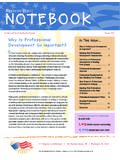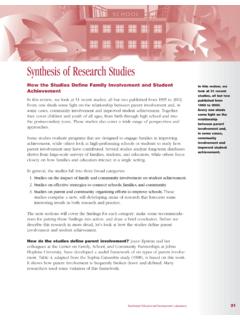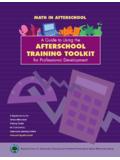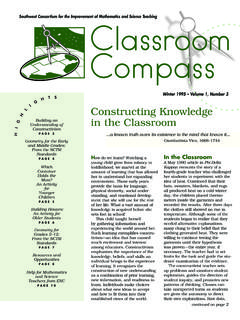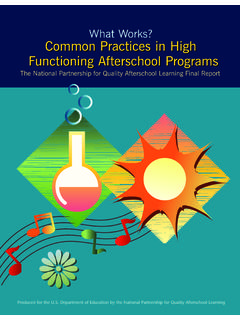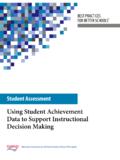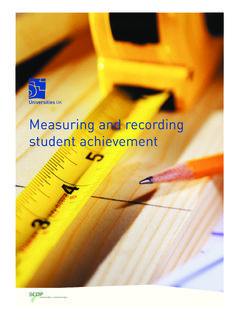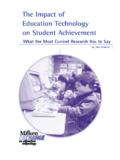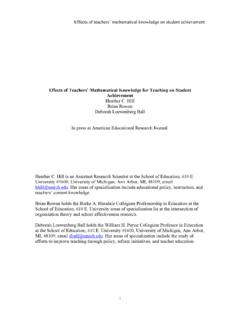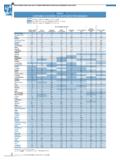Transcription of What Is Instructional Leadership and Why Is It So Important?
1 READINGFIRSTNOTEBOOKThe Newsletter for the Reading First ProgramSpring Department of Education 400 Maryland Avenue, SW Washington, DC 20202 View this newsletter online or subscribe to receive it by e-mail at This Is Instructional Leadership and Why Is It So Important? .. 1 Central Office Leadership .. 2 Reading First Leadership at the School Level:The Principal ..3 The Principal's Role in InstructionalLeadership: One State's Story .. 5 Reading First Coaches as Instructional Leaders ..5 The Reading Coach's Role in Instructional Leadership :A Firsthand Account.
2 6 Helpful Hints .. 7 Resources .. 8 Reading First Levels of ParticipationAs of 3/15/051,391district awards representing4,748schools have been school Leadership today must combine the traditional school lead-ership duties such as teacher evaluation, budgeting, scheduling, and facilitiesmaintenance with a deep involvement with specific aspects of teaching andlearning. Effective Instructional leaders are intensely involved in curricularand Instructional issues that directly affect student achievement (Cotton,2003).
3 Research conducted by King (2002), Elmore (2000), and Spillane,Halverson, and Diamond (2000) confirms that this important role extendsbeyond the scope of the school principal to involve other leaders as key players in Instructional Leadership include the following:1) Central office personnel (superintendent, curriculum coordinators, etc.) 2) Principals and assistant principals3) Instructional coachesSome key elements of Instructional Leadership include the following:1) Prioritization:Teaching and learning must be at the top of the priority liston a consistent basis.
4 Leadership is a balance of management and vision(NAESP, 2001).While leaders cannot neglect other duties, teaching andlearning should be the area where most of the leaders scheduled time ) Scientifically based reading research (SBRR): Instructional leaders mustbe well informed of SBRR and effective reading instruction in order toassist in the selection and implementation of Instructional materials andto monitor implementation. Leaders participation in professional devel-opment sessions will help them remain informed and will provide afocus for Is InstructionalLeadership and Why Is It So Important?
5 A clearly defined understanding of Instructional leadershipis imperative if that Leadership is to be effective. Department of EducationCentral Office LeadershipLeaders are expanding their traditional roles to include supports for improvements in teaching and learning. he traditional roles of the central office Leadership varywidely from policy implementation and monitoring to budget-ing and public leaders at the central office levelmove toward a model of Instructional Leadership , their rolescan change traditional responsibilities stillmust be met, priorities should be shifting toward instructionalissues that will impact classroom instruction and studentachievement.
6 Some of those elements include promoting avision; creating alignment of curriculum, instruction, assess-ment,and standards;focusing on data;and maintaining a cul-ture of continuous learning (Lashway, 2002). By applying forand receiving a Reading First subgrant, a district has recog-nized the need to focus on Instructional priorities and made acommitment to provide Instructional Leadership to its participating schools to maximize the likelihood of the program s following vignette is a fictional account of what mighthappen, based on the strongest evidence of best practices.
7 If ideal implementation of Instructional Leadership transpires at the central office leaders at the Rising Star School District centraloffice have resolved that early literacy instruction will be adistrict priority. This district has applied for and received aReading First leaders know they are responsible forT3) Focus on alignment of curriculum, instruction, assess-ment, and standards: If student achievement is the goaland that goal is measured by standards-based assess-ments, the curriculum, instruction, and assessments allmust be aligned with the standards.
8 If there is a discon-nect among these elements, student achievement willnot be is an ongoing process as standards, curriculum, and assessments cycle ) Data analysis: In their focus on improving achievement ,effective leaders use multiple sources of information toassess performance (NAESP, 2001). Decisions at all levelsmust be based on pertinent data. Central office staff canuse data to help principals become more effective instruc-tional leaders and to make decisions regarding policy andcurriculum. Principals can use data to help guide theinstructional focus and professional development of teach-ers.
9 Coaches can use data to determine the effectivenessof Instructional strategies. Coaches can also assist teachersin using data to establish student grouping arrangementsand pinpoint specific student intervention ) Culture of continuous learning for adults: Effective instruc-tion is a skill that can never be teachers canbenefit from additional time and support to improve indicates that effective principalshave a view of Instructional improvement as an ongoingprocess (Chase & Kane, 1983). Leaders that maintainlearning as a priority will provide released time for teach-ers to attend relevant will follow up bymonitoring and providing the support that sustains thenew expectations set by the leaders regarding priorities, SBRR,alignment, data use, and continued learning will impact class-room instruction and student leaders at alllevels of the system have a clear and important role in supporting those improvement :Chase, G.
10 , & Kane, M. (1983).The principal as Instructional leader: How muchmore time before we act?Denver, CO: Education Commission of the , K. (2003).Principals and student , VA:Association for Supervision and Curriculum , R. (2000). Building a new structure for school ,DC: The Albert Shanker ,D.(2002).The changing shape of Leadership ,59(8),61 Association of Elementary School Principals,(2001).Leading learningcommunities: Standards for what principals should know and be able to ,VA: National Association of Elementary School ,J.
